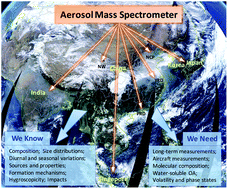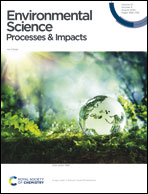A review of aerosol chemistry in Asia: insights from aerosol mass spectrometer measurements†
Abstract
Anthropogenic emissions in Asia have significantly increased during the last two decades; as a result, the induced air pollution and its influences on radiative forcing and public health are becoming increasingly prominent. The Aerodyne Aerosol Mass Spectrometer (AMS) has been widely deployed in Asia for real-time characterization of aerosol chemistry. In this paper, we review the AMS measurements in Asia, mainly in China, Korea, Japan, and India since 2001 and summarize the key results and findings. The mass concentrations of non-refractory submicron aerosol species (NR-PM1) showed large spatial distributions with high mass loadings occurring in India and north and northwest China (60.2–81.3 μg m−3), whereas much lower values were observed in Korea, Japan, Singapore and regional background sites (7.5–15.1 μg m−3). Aerosol composition varied largely in different regions, but was overall dominated by organic aerosols (OA, 32–75%), especially in south and southeast Asia due to the impact of biomass burning. While sulfate and nitrate showed comparable contributions in urban and suburban regions in north China, sulfate dominated inorganic aerosols in south China, Japan and regional background sites. Positive matrix factorization analysis identified multiple OA factors from different sources and processes in different atmospheric environments, e.g., biomass burning OA in south and southeast Asia and agricultural seasons in China, cooking OA in urban areas, and coal combustion in north China. However, secondary OA (SOA) was a ubiquitous and dominant aerosol component in all regions, accounting for 43–78% of OA. The formation of different SOA subtypes associated with photochemical production or aqueous-phase/fog processing was widely investigated. The roles of primary emissions, secondary production, regional transport, and meteorology on severe haze episodes, and different chemical responses of primary and secondary aerosol species to source emission changes and meteorology were also demonstrated. Finally, future prospects of AMS studies on long-term and aircraft measurements, water-soluble OA, the link of OA volatility, oxidation levels, and phase state were discussed.

- This article is part of the themed collection: Organic Aerosols


 Please wait while we load your content...
Please wait while we load your content...